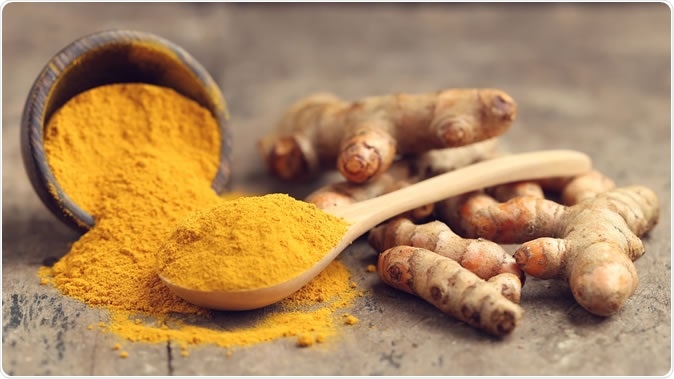Turmeric is a brightly colored yellow spice with numerous health benefits, including anti-inflammatory and anti-carcinogenic. However, a recent study shows that the turmeric grown in Bangladesh can contain the highly poisonous heavy metal lead up to 500 time normal levels.

Turmeric powder and fresh turmeric - Image Credit: Tarapong Srichaiyos / Shutterstock
Seven out of nine turmeric-growing districts produced turmeric adulterated with a toxic bright yellow lead-containing compound called lead chromate. The addition is typically done during the polishing of turmeric, and is carried out on the instructions of turmeric merchants who want to sell inferior-quality turmeric at a higher price. The study also traces the issue to consumer demand for bright yellow turmeric.
![Lead chromate. FK1954 [CC0], via Wikimedia Commons Lead chromate. FK1954 [CC0], via Wikimedia Commons](https://d2jx2rerrg6sh3.cloudfront.net/image-handler/picture/2019/9/Lead_chromate.jpg)
Lead chromate. FK1954 [CC0], via Wikimedia Commons
Lead is highly poisonous, affecting the delicate nerve cells that regulate the whole running of every higher life form. There is no safe limit for lead consumption. However, the study shows that the chief cause for high lead levels among Bangladeshis is probably the intake of turmeric. The study was published on September 17, 2019, in the journal Environmental Research.
Lead isotopes have the same chemical properties but different atomic weights. It is possible to determine the origin of the lead by determining the ratio of lead isotopes in a sample. In this manner, the current study traced the lead found in the blood to the lead chromate used to spike the turmeric samples. This is the first study to make a direct connection between the two.
Bangladesh, a South Asian country bordering India’s northeastern coast, is among the leading producers of turmeric. Following a flood in the eighties, most of the turmeric crop was left soggy which dulls the color. To restore the color, lead chromate, which is used to color furniture and toys, was added during the processing of the spice. However, once the practice began, it continued to be in vogue as a way to make a quick buck out of even inferior-quality turmeric. This insight came from interviews with farmers and spice processing units in many districts of Bangalore.
In a detailed study, the researchers found that lead in turmeric reached over 1000 μg/g in the two districts with highest contamination rates. The samples of soil and pigment from the polishing mills where the actual addition is done showed over 4000 μg/g of lead, and 2% to 10% of lead by weight, respectively.
The researchers have been studying lead exposure in Bangladesh’s rural population for several years, since their first survey which found high blood levels in over 30% of pregnant women in that country.
Lead exposes both adults and children to disease of the heart and brain, and impairs neurodevelopment in children.
Nine out of ten children with high lead levels in the blood live in low-income countries, and almost a trillion dollars’ worth of productivity is lost every year due to lead-induced neurologic damage.
The potent neurotoxicity of lead means that even traces of lead in any substance conceivably used as food or coming into contact with the digestive system are unacceptable.
Export of adulterated turmeric
The study points out that turmeric outside Bangladesh hasn’t been directly linked to lead contamination. Moreover, the stringent safety checks on imported turmeric by several nations have stimulated spice processors in Bangladesh to reduce the amount of lead added to the spice intended for export.
Nonetheless, the safety checks are intermittent, and may allow a substantial majority of the turmeric exported to escape notice. It is noteworthy that 15 or more brands of turmeric traded to a number of countries have been recalled since 2011 because of high lead levels in them.
The problem so far is that no study until now identified the source, though a few have indicated the possibility of its arising from lead-contaminated soil.
Additionally, no study clearly linked the lead in turmeric to that in blood, or defined the worldwide magnitude of the problem, neither have they shown the incentives driving the continuing adulteration of turmeric.
The present work will drive continued research on the best ways to change consumer preferences towards healthy turmeric, and to stop adulteration.
The researchers say better turmeric drying technologies for quick and effective processing will help reduce the need for artificial colorants. They also advise the use of X-ray screeners to detect lead and other heavy metals in turmeric imports.
The study concludes that not just producers but also consumers of turmeric must engage in a productive dialogue, along with public health authorities and other stakeholders, to arrive at a solution that won’t cost the farmers and processors more than it is worth to produce the turmeric in the first place.
In fact, the researchers are already working with scientists from other areas to minimize lead pollution from turmeric, battery recycling, and other potential sources of lead. They also aim to promote low-lead technologies that can be used to generate business opportunities. For instance, one member of the team has come up with a cheap way of measuring lead levels in blood, turmeric and other substances, while others are finding new ways to increase the demand for lead-free turmeric.
Researcher Stephen Luby says, “Jenna's remarkable work allows us to collaborate with stakeholders in Bangladesh to target effective prevention.”
Journal reference:
Turmeric means “yellow” in Bengali: Lead chromate pigments added to turmeric threaten public health across Bangladesh. Jenna E.Forsyth, Syeda Nurunnahar, Sheikh Shariful Islam, Musa Baker, Dalia Yeasmin, M. Saiful Islam, Mahbubur Rahman, Scott Fendorf, Nicole M. Ardoin, Peter J. Winch, & Stephen P. Luby. Environmental Research, Volume 179, Part A, December 2019, 108722. https://doi.org/10.1016/j.envres.2019.108722. https://www.sciencedirect.com/science/article/pii/S0013935119305195